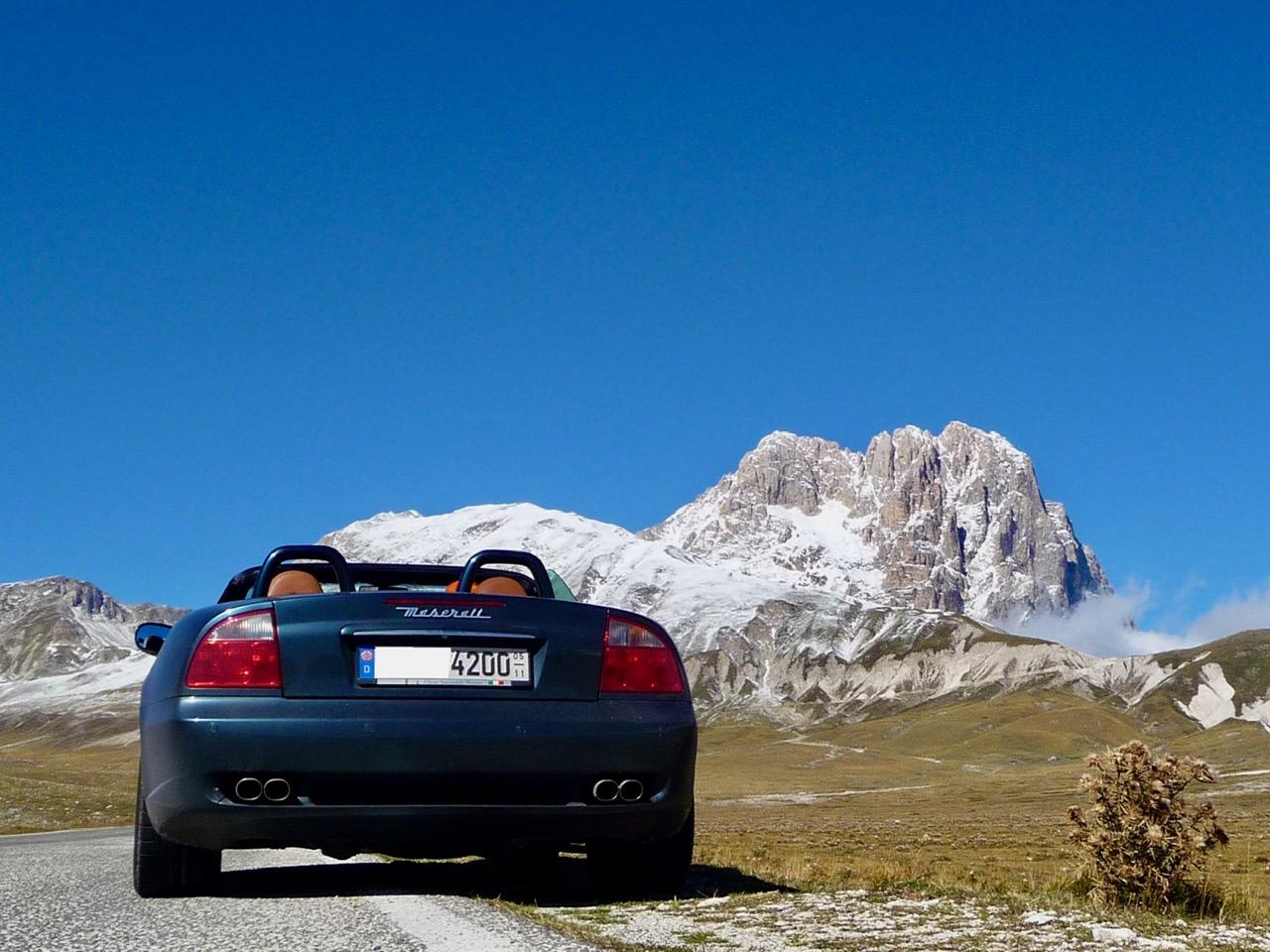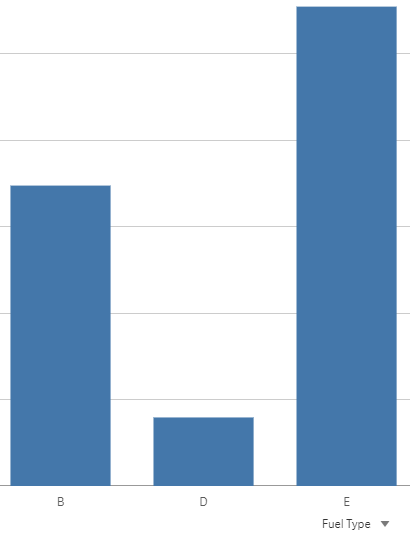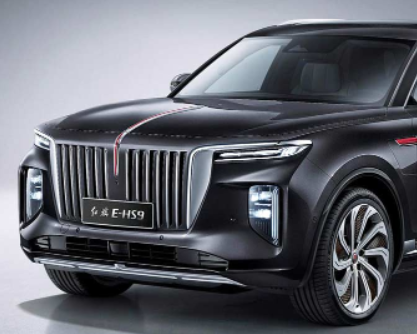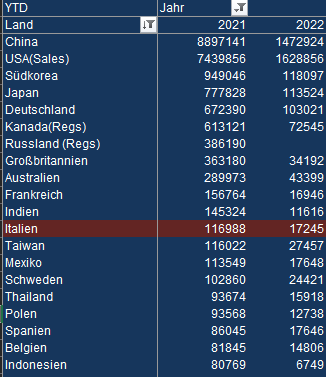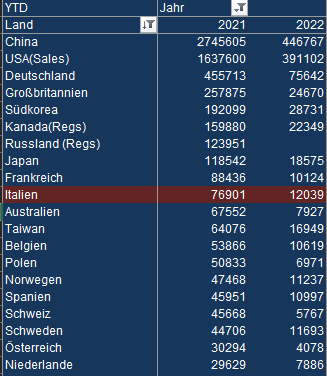-
Numero contenuti pubblicati
12977 -
Iscritto il
-
Ultima visita
-
Giorni Massima Popolarità
56
Tipo di contenuto
Forum
Galleria
Calendario
Download
Articoli del sito
Store
Blog
Tutti i contenuti di 4200blu
-
Va‘bene, questa si devo accetare, i gusti sono diversi…lo so bene, perche a me piace la Multipla (quella prima pre-restyling) 😁
- 204 risposte
-
- 4
-

-
Si, E sono solo bev.
- 2479 risposte
-
- 1
-

-
- alfa romeo
- stellantis
-
(e 1 altro in più)
Taggato come:
-
Produzione G26 per alimentazione Benzina, Diesel, Elettrica La richiesta per la i4 e molto piu alta come il possibile volume della produzione, problema principale al momento sono le batterie non disponibile in volume necessario, ma prossimo anno molto probabile la situazione migliorera, volume per la i4 poi in aumento forte. Al momento tempi di attesa per la i4 (almeno per Germania e credo simile per UK) 12-15 mesi.
- 2479 risposte
-
- 3
-

-

-

-
- alfa romeo
- stellantis
-
(e 1 altro in più)
Taggato come:
-
...senza dubbio la BMW piu brutta per sempre, molto probabile ancha sotto le tre macchine piu brutte in generale.....🥶
- 204 risposte
-
Stoccarda --> Costa Azzura in 11:32 per 1008Km. Velocita media 87,4Km/h, velocita max 140Km/h, consumo medio 8,7kWh/100Km
- 63 risposte
-
- 2
-

-

-
- mercedes vision eqxx
- vision
-
(e 6 altri in più)
Taggato come:
-
Stellantis CEO Tavares' pay sparks anger ahead of French election Stellantis CEO Carlos Tavares' compensation 'not normal,' French government says PARIS -- Stellantis CEO Carlos Tavares' 2021 pay drew an angry response from some trade unions on Wednesday, days ahead of a French presidential vote fought largely over cost-of-living concerns. Minority Stellantis shareholder Phitrust estimated the value of the total compensation package awarded last year to Tavares at 66 million euros ($71 million) ahead of the automaker's group’s first annual general meeting. The group's chairman, John Elkann, said Stellantis would take into account the shareholder vote, which he described as a recommendation, even though the executive remuneration report for senior managers, including Tavares, was opposed by more than 52 percent during Wednesday's meeting. The vote however will not affect planned compensations for last year, based on Netherlands law, where Stellantis is based. "Today's vote on remunerations is only consultative, so the remuneration report for 2021 will be implemented," a source close to the matter told Reuters. "It is our conviction as a board that in a meritocracy, rewarding on the basis of performance criteria is a fundamental element of our policy," Elkann told shareholders. "We will take on this vote which is, again, a recommendation". Phitrust, which issued a news release to say it had voted against approving the package, said Tavares' 2021 pay of about 19 million euros would add to a stock package worth an additional 32 million euros and long-term compensation of roughly 25 million euros. A Stellantis spokesperson disputed the 66-million-euro figure put forward by Phitrust as "false". "The real compensation for 2021 is around 19 million euros. The remainder are hypothetical elements for the long-term, until 2028," added the spokesperson for Stellantis. The automaker, which includes the Jeep, Ram, Opel and Maserati brands, was formed in January 2021 by the merger of PSA Group, where Tavares was CEO, and Fiat Chrysler Automobiles. Gabriel Attal, the spokesman for the French government, which holds 6.15 percent of Stellantis through state-owned bank BPIFrance, told a press briefing the figures were not "normal" and showed there was a need for more regulation at the European level. BPIFrance was among those that voted against the pay package. Jean-Pierre Mercier, a union representative for the hard-left CGT union, called the package "indecent and revolting," while CFDT representative Christine Virassamy urged politicians to take urgent measures to cap executive salaries. President Emmanuel Macron, a pro-European economic liberal, and far-right nationalist challenger Marine Le Pen have qualified for what promises to be a tightly fought presidential election runoff on April 24. "These situations contribute and, unfortunately, lead to citizens taking up extreme positions during elections," Virassamy said in a statement. Stellantis had in February reported a 2021 net profit that close to tripled year on year to 13.4 billion euros. It voted Wednesday to pay out 3.3 billion euros in dividends. The group's largest trade unions did not immediately comment on Tavares' pay package. Tavares' 2021 compensation is expected to make him the highest-paid automotive CEO in Europe. Volkswagen Group CEO Herbert Diess earned just under 8 million euros in 2020. In the U.S., GM CEO Mary Barra earned $23.7 million in 2020 (about 21.9 million euros at current exchange rates). Automotive News Europe has calculated that if Tavares achieved all the targets of his compensation incentives and plans, he would be entitled to receive more than 220 million euros by 2026. Former Renault Group CEO Carlos Ghosn also faced criticism over his pay from the French government. Ghosn was simultaneously chief executive of both Renault and alliance partner Nissan for a number of years, and drew a multimillion-dollar compensation package from both automakers. It was reportedly the prospect of reduction in pay from Nissan that led to Ghosn’s alleged involvement in what Japanese prosecutors say was an effort to hide millions more in compensation. Ghosn has denied the allegations since his arrest in 2018, and he remains in Lebanon after fleeing there at the end of 2019 rather than face trial in Japan. (ANE)
-
Dongfend Aeolus Haoji
-
- 2632 risposte
-
- 6
-

-

-

-
- elettrico fiat
- fiat elettrica
- (e 15 altri in più)
-
no...e il S68B44T0.
-
Korean electric car battery prices may jump 40% Korean electric car battery prices may jump 40% in the next 2 years to offset high commodity costs South Korean battery makers could raise prices by 30 percent to 40 percent to offset high commodity costs and they are in talks with electric vehicle makers over new long-term contracts, according to SNE Research. “We had a meeting with Korean cell makers recently that led us to adjust the outlook for prices of electric-car batteries,” SNE Executive Vice President James Oh said at a seminar Wednesday. “They say battery prices are highly likely to rise by 2024 or 2025.” While the companies didn't disclose how much they might increase prices by, those using lithium, nickel, cobalt and manganese could lift prices of battery packs as much as 40 percent by 2025, Oh told Bloomberg News on the sidelines of the event. Last year, the average lithium-ion battery pack for an EV was between $147 and $153 per kilowatt hour, according to SNE Research. Batteries account for about 30 percent to 40 percent of the price of an EV. Rising lithium prices are also affecting solid-state-batteries that use sulfide electrolytes, LG Energy Solution Vice President Jay Kim said at Wednesday's seminar in Seoul. “Sulfide-electrolyte-based solid-state batteries are extremely expensive compared to other types of solid-state batteries and need a lot of lithium,” Kim said. “Prices of sulfide electrolyte could double from last year's level.” With labs in South Korea and the U.S., LG is working on commercializing sulfide-electrolyte-based solid-state cells by 2030, Kim said. Global automakers are pushing Korean battery partners to change to prismatic-shape cells from pouch-type ones being produced now, as they believe they are safer, Oh said. Volkswagen Group is among them, and its partner, SK On, is likely to announce a prismatic plan soon, he said. Samsung SDI is the only South Korean battery maker with the technology for manufacturing the cells. “You need to be a bit careful with handling pouch-type cells, which have a higher possibility of swelling than prismatic ones,” Samsung SDI Vice President Lee Tae Kyung said during a presentation on battery safety. (ANE)
- 4226 risposte
-
- transizione ecologica
- bev
-
(e 2 altri in più)
Taggato come:
-
e troppo poco per il gusto cinese...pensano completamente diverso, forse non e comprensibile per un italiano, ma il gusto cinese e italiano e diverso di 180 gradi. A loro piace roba cosi....
-
..dubito che questa sistema/tecnologia sara il futuro in europa - HR-V hybrid ha un consumo di 122g CO2, non basterebbe neanche approssimamente per raggiungere i target dei prossimi anni (fino 2030 a ca. 43g). Senza Bev (o phev, ma questa sicuramente troppo complicato, voluminoso e caro per seg. A/B) non raggiungi mai.
- 4226 risposte
-
- transizione ecologica
- bev
-
(e 2 altri in più)
Taggato come:
-
Nuovi prezzi in Germania: aumento X7 base da 95.400.- a 97.700.-€ aumento X7M da 122.200.- a 127.200.-€
-
Forse una conseguenza della cancellazione del salone del Pecchino, dove la presentazione reale sarebbe effetuarsi, adesso tutto virtuale, forse per questo hanno dato precedenza al prodotto/mercato americano con la X7.
-
Giusto per curiosità. Questo stile così estremo, perché per una BMW è estremo, è dovuto ad una intuizione o a particolari richieste? ...sopratutto richiesta dei clienti cinesi...in Cina voglio frontali appariscenti, imponenti ma non cattivo, idealmente un frontale per loro e grintoso e sorridente allo stesso tempo.
-
..la sensazione per disegni e sempre individuale e diverso, ma secondo il mio gusto purtroppo con la 7 avrei un effetto simile. si, non so perche hanno cambiato l'ordine, originario era pensato viceversa.
-
...ma gia adesso prenotazione benone per il maialone....😄, molto lavoro in arrivo per Dingolfing...........
-
- 4226 risposte
-
- 3
-

-

-
- transizione ecologica
- bev
-
(e 2 altri in più)
Taggato come:
-
Honda pours $40B into electrification, targets 2 million EV output by 2030 The latest announcement builds on a string of initiatives CEO Toshihiro Mibe is taking to make the lineup at Japan’s No. 2 automaker completely gasoline-free by 2040. TOKYO – Honda Motor, in the midst of a radical corporate makeover, said it will invest 5 trillion yen ($39.91 billion) over the next 10 years in electrification and software as it rolls out 30 full electric vehicles globally and builds production capacity for 2 million EVs annually by 2030. In announcing the new push on Tuesday in Japan, Honda said it will also shift its business away from non-recurring hardware sales toward recurring sales of services that combine hardware and software. It is part of new software-defined EV platform, dubbed e:Architecture, that the company will launch in 2026 to underpin the next generation of large-sized battery electric cars from Honda. Honda said the 5 trillion yen dedicated to electrification and software constitutes the lion’s share of the total r&d budget of 8 trillion yen ($63.86 billion) allotted over the same period. CEO Toshihiro Mibe detailed the plans at Honda’s global headquarters, saying Japan’s No. 2 automaker would pursue a multi-pronged approach toward its goal of having a gasoline-free lineup by 2040. On one hand, it will work with partners in the near term to achieve scale and cut cost. On the other, it will develop its own in-house technologies to sustain it in the long run. Among other elements announced April 12, Honda will spend 43 billion yen ($343.2 million) to open a demonstration line for producing next-generation solid-state batteries in the spring of 2024. It wants to bring the lighter, energy-dense batteries to market in the late 2020s. In the meantime, Honda will keep sourcing Ultium lithium ion batteries from General Motors and also explore other joint ventures for battery production locally in North America. In China, it will partner with CATL, and in the home market of Japan, it will get batteries for a new series of mini-EVs from Envision AESC, the battery maker that also supplies rival Nissan Motor Co. Honda will also leverage swappable batteries as part of its future power pack strategy. Mibe said that Honda also wants to launch two all-electric sports cars in the mid-2020s. One will be a “specialty” vehicle, the other will be a “flagship model.” Teaser shots of cars under wraps depicted low-slung silhouettes reminiscent of the NSX that will be discontinued this year. “From 2030 and beyond, we believe that we will be entering into the full popularization period, and battery EVs will be commonplace,” Mibe said. “We will have small, medium and large-sized platforms in place and cover all the segments with these three platforms.” The announcement builds on a string of initiatives Mibe is taking to transform the automaker. Earlier this month, Honda announced it would team up with General Motors to to sell millions of co-developed “affordable” EVs starting in 2027. And last month, Honda said it would partner with Japanese electronics giant Sony Corp. to market co-developed EVs from 2025. Honda Executive Vice President Kohei Tekeuchi said the 2 million EVs Honda will be prepared to produce in 2030 represent about 40 percent of its 5 million global output plan that year. With global volume around 5 million vehicles, Honda hopes to achieve a 7 percent operating profit margin, up from the 5.5 percent expected in the fiscal year just ended March 31. Honda, which sells about 4.5 million vehicles a year worldwide, has a long way to go before going pure BEV. To date, it has sold only 32,649 battery-electrics, cumulatively, since marketing its first, the Honda EV Plus, in 1997. Honda sold almost half those EVs, 14,324 units, in 2021 alone. Honda has made a much bigger dent with hybrids, a segment it helped pioneer with the Insight. It has sold 3.91 million cumulatively over the years, including 561,165 gasoline-electrics in 2021. The limited-run EV Plus, a squat three-door micro car, was Honda’s first EV, but the battery-powered version of the low-selling Clarity sedan was the first to be marketed in the U.S. Today, its only global all-electric offering is the Honda e urban runabout. Honda has sold 9,226 of the subcompact hatchbacks in Europe and Japan through the end of 2021, including 4,171 units last year. Honda also sells three locally-focused EV models in the China market. Tailored and global As a mid-sized player on the global stage, Honda needs the help of friends. For a long time, it has circled wagons with General Motors on a range of projects, from hydrogen fuel cell technology to electric vehicles. But Mibe has been actively courting new partners. Mibe stressed that gasoline-electric hybrids would remain a key element of Honda’s lineup well into the 2030s and that he expects demand for them to increase in places such as middle America. “We will continue to rely on hybrids as one of our powerful weapons,” he said. In terms of EV offerings, Honda sees three platforms ahead in the near term. One platform will be a mini and subcompact EV platform developed for Japan and Asia. In Honda's home market, it will debut as a commercial mini vehicles. The other is a midsize EV platform being jointly developed with GM. The third is the in-house e:Architecture framework, which will underpin larger vehicles, especially those for North America and China, Mibe said. Of the 30 EVs Honda plans to launch by 2030, 10 will debut in China through 2027. “Through the second half of the 2020s, which will be the dawn of the popularization of EVs, we will introduce products tailored to the characteristics of each region, such as our key EV markets of North America, China and Japan,” said Shinji Aoyama, the senior managing executive officer in charge of Honda’s electrification strategy. “After the second half of the 2020s, we assume it will be the period of EV popularity. At this stage, we will begin introducing the best EVs from a global perspective.” Partnership bridges Partnerships with GM and Sony can been seen as a bridge to the time when Honda develops its own next-generation EV platforms and advanced solid-state battery systems. Cooperating buys time for Honda by giving it quicker access to product for sale and help on technology. Mibe said the new venture with Sony will be separate from the Honda brand and its existing electric vehicle strategy. The plan to share an EV platform with GM for the North American market, for instance, will stay on track and is important as a mass market play, he said. The vehicles developed by Honda and GM, mostly compact crossovers, will be based on a new global electric architecture powered by GM's Ultium battery technology and use jointly created advanced battery technology. Plans to sell millions could make the pair global EV leaders. The companies have a North American alliance dating to 2020, in which GM agreed to help Honda build EVs on its existing Ultium battery platform. That collaboration is already on track to deliver two crossovers in 2024, the Honda Prologue and a counterpart EV from Acura. Phasing out ICE Mibe plans to phase out the company’s famed internal combustion engines by 2040 on the road to transforming Honda into a carbon-neutral power and mobility provider. Its upcoming e:Architecture and solid-state batteries will play a key role. Mibe calls solid-state batteries a “game-changer.” Development is already underway as Honda is redeploying engineers from the company’s internal combustion engine business to battery development. Outside of electrification of its automobile lineup, Honda is embarking on a wider makeover. It is developing autonomous vehicles, in part with GM’s Cruise, under a mobility-as-a-service enterprise. Last September, Honda said it will branch into electric vertical take-off and landing, or eVTOL, aircraft with the aim to commercialize the craft by 2030, and then break the bonds of earth all together by developing small, reusable rockets that can put satellites into low-earth orbit. Honda also confirmed last autumn it had already conducted combustion tests of its prototype rocket. Another new focus area will be avatar robots -- machines with arms, hands and fingers that motion-capture real human movement to “make virtual mobility possible.” “Preparing for new growth” is the other direction Honda has been pursuing,” Mibe said in Tokyo. “We will create more free time for people and expand time and space where people take active roles, to remove any constraints on people’s freedom of mobility. By realizing such value, we will strive to expand the range of human living and activities, and become a driving force to help change our society.” (ANE)
- 21 risposte
-
- 1
-

-
VW expects microchip shortage to last until 2024 Supplies of semiconductors will not normalize until 2024, by which time there will still be a structural undersupply, VW Group finance chief Arno Antlitz said. BERLIN -- Volkswagen Group expects the semiconductor shortage to continue longer than expected, the automaker's finance chief Arno Antlitz said. Supplies of semiconductors will not normalize until 2024, by which time there will still be a structural undersupply, Antlitz said in an interview with Boersen-Zeitung published on Saturday VW Group has been forced to halt production at several factories including its Wolfsburg plant and its EV factories in Zwickau and Dresden, Germany, several times due to a lack of chips. Antlitz said he expects the semiconductor situation to ease this year and next year, but the shortage will continue into 2024 because chipmakers will not be able to meet rising demand for semiconductors even as more chip production comes on line. "We see a structural undersupply in 2022, which is only likely to ease somewhat in the third or fourth quarter," he said. "The situation should improve in 2023, but the structural problem will not yet have been fully resolved. BMW Group CEO Oliver Zipse made similar predictions in an interview with newspaper Neue Zuercher Zeitung published on Monday. "We are still in the height of the chip shortage," Zipse was quoted as saying. "I expect us to start seeing improvements at the latest next year, but we will still have to deal with a fundamental shortage in 2023." BMW said during its annual press briefing in mid-March that it expected the chip shortage to last throughout 2022. Automakers are dealing with the double challenge of the microchip shortage and disruption of wire cable harnesses manufactured in Ukraine caused by Russia's invasion of the country. Antlitz said individual VW Group plants are continually forced to cancel shifts because the automaker's supplier in the Ukraine is only operating on a single-shift basis. "We have set up a crisis team and, in some cases, also shifted volumes to other production facilities of the same suppliers. However, the alternative locations are not intended to replace the production sites in Ukraine in the long term. We stand by our existing supplier sites in Ukraine and provide support where we can," Antlitz said. Looming energy crisis Asked about rising energy costs and the possibility of a ban of imports into Germany of Russian natural gas, Anlitz said the automaker has not yet decided when to implement its plan to convert power plant operations in Wolfsburg from coal to natural gas. "We haven't switched over yet. But we are currently in the process of switching over. At the moment, the coal-fired power plant is still running while the gas-fired power plant is ramping up. We are watching very closely what happens in the next few days and weeks. At the moment, we haven't decided when we will finally shut down the coal-fired power plant." Antlitz also reiterated plans for a possible IPO of VW Group's Porsche's sports-car subsidiary. "There has been a lot of speculation there recently about the timing, but we are still aiming for an IPO in the final quarter," he said. (Reuters)
- 1065 risposte
-
- 1
-

-
- italdesign
- jetta
-
(e 15 altri in più)
Taggato come:
-
Non devi slavare il date, perche con una inflazione media per 10 anni di 5% (che molto probabile potrebbe essere anche di piu se vedi cosa succede al momento) poi questi 10k di oggi sono gia 16k in 10 anni. E poi tutte le contenuti addizionali di un auto della 2032, potresti essere contentissimo, se ci sara una auto per 20k.
- 4226 risposte
-
- 1
-

-
- transizione ecologica
- bev
-
(e 2 altri in più)
Taggato come:
-
..non sono sicuro se questa econ domanda/offerta e davvero cosi. come ricevo io la situazione sta cambiando molto veloce al momento. La domanda per le bev in Europa e in forte aumento, i tempi di attesa per molto bev sono lunghi e lunghissimi (naturalmente amplificato con i problemi conosciuti, mancanza componenti, guerra, supply chains disturbati). Un certo produttore bavarese gia nel 2023 per l'europa potrebbe raggiungere una quota di significante sopra 20% per le vendite bev, cosi ancora 6-7 anni piu avanti non sarebbe completamente irreale una quota delle bev di 80-90% (sempre per EU, gli stati sicuramente altra discussione).
- 4226 risposte
-
- 1
-

-
- transizione ecologica
- bev
-
(e 2 altri in più)
Taggato come:
-
- 4226 risposte
-
- transizione ecologica
- bev
-
(e 2 altri in più)
Taggato come:
-
- 2479 risposte
-
- alfa romeo
- stellantis
-
(e 1 altro in più)
Taggato come:
-
...ma quella non producono in Cina come gia oggi la DS9 ?
- 7888 risposte
-
- psa
- siti produttivi
-
(e 3 altri in più)
Taggato come:

